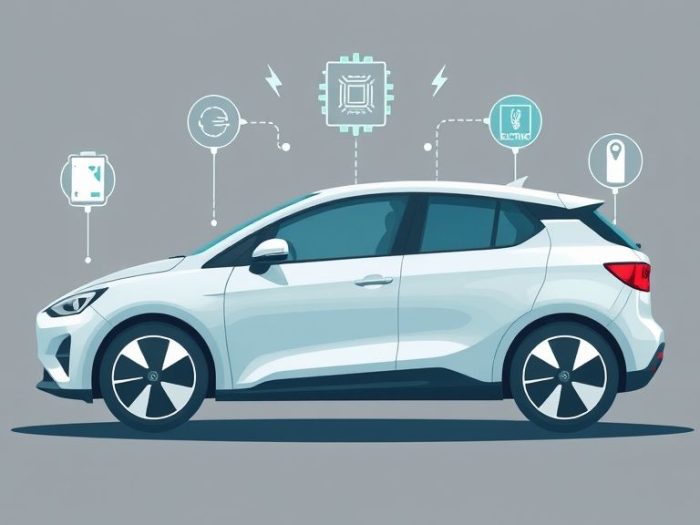The electric vehicle (EV) revolution is transforming the automotive industry, creating
significant investment opportunities. While Tesla and charging stations grab headlines,
the EV supply chain extends far beyond these familiar names. This article explores the
diverse and crucial components of the EV supply chain, highlighting key investment
areas.
Understanding the EV Supply Chain
The EV supply chain encompasses all the activities and companies involved in designing,
manufacturing, and delivering electric vehicles. It’s a complex ecosystem that includes:
- Raw Materials: Mining and processing of materials like lithium, cobalt, nickel, and graphite.
- Components: Manufacturing of batteries, electric motors, power electronics, and other EV components.
- Vehicle Manufacturing: Assembly of EVs by automakers.
- Charging Infrastructure: Development and deployment of charging stations and related technologies.
- Software and Technology: Development of software, operating systems, and autonomous driving technologies for EVs.
- Recycling and End-of-Life: Recycling of batteries and EV components.
Beyond Tesla and Charging Stations: Key Investment Areas
While Tesla and charging stations are important, consider these often-overlooked areas:
1. Raw Materials
The demand for raw materials used in batteries is surging.
- Lithium: A key component of EV batteries. Companies involved in lithium mining and processing.
- Cobalt: Another essential battery material. Ethical sourcing and supply chain transparency are crucial.
- Nickel: Used in battery cathodes. Companies with efficient and sustainable mining practices.
- Graphite: Used in battery anodes. Companies producing synthetic or sustainably sourced graphite.
2. Battery Technology
Battery technology is constantly evolving, and companies developing next-generation
batteries are poised for growth.
- Solid-State Batteries: Companies working on safer and more energy-dense batteries.
- Battery Management Systems (BMS): Companies developing software and hardware to optimize battery performance.
3. Power Electronics
Power electronics control the flow of electricity in EVs.
- Inverters: Devices that convert DC power from the battery to AC power for the motor.
- Converters: Devices that regulate voltage levels in the vehicle.
4. Charging Infrastructure Technology
Beyond charging station deployment, consider:
- Smart Charging: Software and hardware for optimizing charging efficiency and grid integration.
- Wireless Charging: Companies developing wireless charging solutions.
5. Recycling and End-of-Life Solutions
As the number of EVs increases, responsible battery recycling becomes critical.
- Battery Recycling: Companies developing efficient and environmentally friendly battery recycling processes.
- Second-Life Applications: Finding new uses for used EV batteries (e.g., energy storage for buildings).
Investment Strategies
- Diversification: Invest across different segments of the EV supply chain to reduce risk.
- Technology Focus: Consider investing in companies developing innovative technologies.
- Long-Term Perspective: The EV market is expected to grow significantly over the long term.
- ESG Considerations: Evaluate companies based on their environmental and social responsibility.
Risks of Investing in the EV Supply Chain
- Competition: The EV market is highly competitive.
- Technological Change: Rapid technological advancements can disrupt the industry.
- Supply Chain Disruptions: Global events can impact the supply of raw materials and components.
- Regulatory Changes: Government policies and regulations can affect EV adoption.
Conclusion
The EV supply chain offers diverse investment opportunities beyond Tesla and charging
stations. By understanding the key components and identifying promising companies,
investors can participate in the growth of the electric vehicle revolution. However, it’s
essential to carefully assess the risks and adopt a long-term perspective.
Related Keywords
Electric vehicle supply chain, EV supply chain, EV stocks, electric vehicle investing,
battery technology stocks, lithium stocks, cobalt stocks, EV charging infrastructure, EV
battery recycling, electric vehicle market.
Frequently Asked Questions (FAQ)
1. What is the EV supply chain?
The EV supply chain encompasses all the activities and companies involved in
designing, manufacturing, and delivering electric vehicles.
2. What are the key components of the EV supply chain?
Key components include raw materials, components, vehicle manufacturing,
charging infrastructure, software and technology, and recycling.
3. Why is raw material supply important for EVs?
Raw materials like lithium, cobalt, and nickel are essential for battery
production, and their availability impacts EV manufacturing.
4. What are some examples of EV components?
Examples include batteries, electric motors, and power electronics.
5. What are some of the next-generation battery technologies?
Solid-state batteries are a key area of development, offering potential
improvements in safety and energy density.
6. What is the role of power electronics in EVs?
Power electronics, like inverters and converters, control the flow of
electricity within the vehicle.
7. What are some investment opportunities beyond charging stations?
Opportunities exist in smart charging technology, wireless charging solutions,
and battery recycling.
8. Why is battery recycling important for the EV industry?
Responsible battery recycling is crucial for sustainability and resource
recovery as the number of EV batteries increases.
9. What are the risks of investing in the EV supply chain?
Risks include competition, technological change, supply chain disruptions, and
regulatory changes.
10. What is the overall investment outlook for the EV supply chain?
The outlook is generally positive, with significant growth potential, but
investors should be aware of the risks and adopt a long-term perspective.



